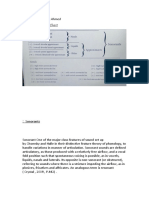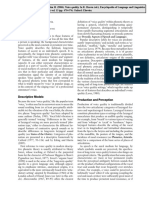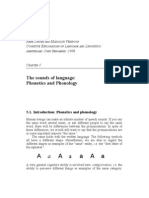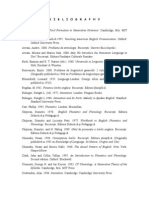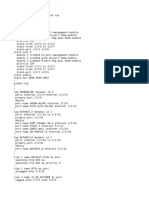Classification and Description. Acoustic Correlates
Classification and Description. Acoustic Correlates
Uploaded by
calluraCopyright:
Available Formats
Classification and Description. Acoustic Correlates
Classification and Description. Acoustic Correlates
Uploaded by
calluraOriginal Title
Copyright
Available Formats
Share this document
Did you find this document useful?
Is this content inappropriate?
Copyright:
Available Formats
Classification and Description. Acoustic Correlates
Classification and Description. Acoustic Correlates
Uploaded by
calluraCopyright:
Available Formats
Chapter 3: The Sounds of English. Consonants and Vowels.
An Articu-latory
Classification and Description. Acoustic Correlates
3.1. Consonants and Vowels. Traditional distinctions. Chomsky and
Halle’s SPE definition
3.2. Criteria for consonant classification. Vocal cord vibration. Sonority
3.3. Manner of articulation. Plosives. Fricatives. Affricates
3.4. Sonorants. The Approximants: glides and liquids
3.5. Oral and nasal articulation
3.6. Force of articulation
3.7. Place of articulation
3.8. The Description of English consonants
A. The Approximants
B. The English Stops
C. The English Fricatives
D. The English Affricates
3.2. Criteria for consonant classification. Vocal cord vibration.
Sonority
Traditionally, the three basic criteria used in the articulatory description of a
sound are vocal cord vibration (voicing), the place of articulation and the manner of
articulation.
As far as voicing is concerned, mention has been made in the chapter describing
the articulatory organs that the vocal cords represent a key element in the articulation of
speech sounds. If the cords vibrate when we produce a sound, the sound thus uttered is
called a voiced sound (Rom. sonor). If, on the contrary, the sound is uttered without vocal
cord vibration, then we are talking about a voiceless sound (Rom. surd). We have already
said that all vowels are voiced, while as regards consonants, they fall into the two
categories mentioned above.
Voicing is not, however, the only parameter that can be used to classify
consonants and other criteria will also be used to cross-classify this pretty numerous and
heterogeneous class of sounds. If vibration of the vocal cords constitutes an important
criterion for differentiating among various sounds, the outgoing airstream may make the
two cavities (oral or nasal) mentioned in the second chapter vibrate. This generates an
acoustic phenomenon we are familiar with from everyday life, namely resonance. The
higher or lower level of resonance produced when a sound is uttered results into a higher
or lower degree of prominence or sonority and leads to a major distinction between two
classes of consonants: sonorants and obstruents. Sonorants will, of course, be called
those sounds having a higher degree of sonority and resonance, while obstruents will be
those consonants characterized by a comparatively lower sonority and involving a much
lower resonance (if any). The level of sonority being higher in the case of sonorants (the
vowels themselves will hold the highest position on a sonority scale), they will
consequently be vowel or vowel-like sounds. The obstruents will be those sounds having
predominantly consonantal features, the class including the so called genuine or true
consonants. In English, all sonorants are voiced, while obstruents may be voiced or
voiceless.
You might also like
- Sundberg1994 Perceptual Aspects of SingingDocument17 pagesSundberg1994 Perceptual Aspects of Singingkarinykelvia95No ratings yet
- Sound Structure in MusicDocument123 pagesSound Structure in Musiclewis_smith_175% (4)
- Anatomy of Voice: How to Enhance and Project Your Best VoiceFrom EverandAnatomy of Voice: How to Enhance and Project Your Best VoiceRating: 4 out of 5 stars4/5 (3)
- The Musical Aspects of the Ancient Egyptian Vocalic LanguageFrom EverandThe Musical Aspects of the Ancient Egyptian Vocalic LanguageRating: 4 out of 5 stars4/5 (2)
- Mathematical Models of MorphogenesisDocument303 pagesMathematical Models of Morphogenesissy734100% (5)
- SNP Heuristic-Based PlanningDocument65 pagesSNP Heuristic-Based PlanningyareddyNo ratings yet
- Classification and Description. Acoustic CorrelatesDocument1 pageClassification and Description. Acoustic CorrelatescalluraNo ratings yet
- Classification and Description. Acoustic CorrelatesDocument2 pagesClassification and Description. Acoustic CorrelatescalluraNo ratings yet
- 4) Classification of Speech SoundsDocument2 pages4) Classification of Speech SoundsGolden MirzaNo ratings yet
- The History of The Theoretical Basis To The Distinctive FeaturesDocument9 pagesThe History of The Theoretical Basis To The Distinctive Featuresanmar ahmedNo ratings yet
- Units 6 - 7: Vowels Vs Consonants The English Vowel SystemDocument23 pagesUnits 6 - 7: Vowels Vs Consonants The English Vowel Systemakhilesh sahooNo ratings yet
- Units 6 7 Vowels Vs Consonants The EngliDocument23 pagesUnits 6 7 Vowels Vs Consonants The EngliMiriam BeltranNo ratings yet
- Phonology 57Document3 pagesPhonology 57SnapeSnapeNo ratings yet
- CHAPTER 2 - копияDocument11 pagesCHAPTER 2 - копияLucifer LightburnNo ratings yet
- What Is Definition of PhonologyDocument12 pagesWhat Is Definition of PhonologyIsriani IshakNo ratings yet
- Classification and Description. Acoustic CorrelatesDocument2 pagesClassification and Description. Acoustic CorrelatescalluraNo ratings yet
- Phonetics SummaryDocument3 pagesPhonetics SummaryIrene Martín RomeroNo ratings yet
- English Sound System: 3.1 PreliminariesDocument58 pagesEnglish Sound System: 3.1 PreliminariesJayakumar RajendranNo ratings yet
- Chapter Three Contrasti Ve Anal Ysi SDocument26 pagesChapter Three Contrasti Ve Anal Ysi SHafsa SalamNo ratings yet
- Elng 101 Module 2Document24 pagesElng 101 Module 2Mutya Kismet LogroñoNo ratings yet
- Correct Distinctive FeaturesDocument7 pagesCorrect Distinctive Featuresanmar ahmedNo ratings yet
- 02chapter 2 SoundDocument98 pages02chapter 2 SoundRoger langaNo ratings yet
- Types of PhoneticDocument5 pagesTypes of PhoneticDwiqha Qatrunnada100% (2)
- The Functions of The SyllableDocument3 pagesThe Functions of The SyllablePatricia Baldonedo100% (2)
- PVA Study Guide Answer Key1Document16 pagesPVA Study Guide Answer Key1Ιωάννης ΠιτσάβαςNo ratings yet
- O. Jespersen: Syllable Formation TheoriesDocument6 pagesO. Jespersen: Syllable Formation Theoriesrita yaremenkoNo ratings yet
- Determining The Distribution of Segments in A Language: Linguistics 200 PhonologyDocument3 pagesDetermining The Distribution of Segments in A Language: Linguistics 200 PhonologyAmine OutaghzaNo ratings yet
- Sonorant by Anmar Ahmed English Sonorant ChartDocument9 pagesSonorant by Anmar Ahmed English Sonorant Chartanmar ahmedNo ratings yet
- Chapter IIIDocument71 pagesChapter IIIerikaNo ratings yet
- I Year B. Tech. Lab NotesDocument39 pagesI Year B. Tech. Lab Notesbalajichakilam2012No ratings yet
- Lecture 3 Classification of English Speech SoundsDocument6 pagesLecture 3 Classification of English Speech SoundsElesetera80% (5)
- Phonetics Class 2Document18 pagesPhonetics Class 2Isabelle GonzálezNo ratings yet
- Prosodic SystemDocument47 pagesProsodic SystemAlina KachurNo ratings yet
- 6-Naturalness and StrengthDocument9 pages6-Naturalness and StrengthMeray HaddadNo ratings yet
- Computer-Assisted Programme For The Teaching of The English Syllable in RP Allophonic PronunciationDocument25 pagesComputer-Assisted Programme For The Teaching of The English Syllable in RP Allophonic PronunciationHafid Tlemcen Rossignol PoèteNo ratings yet
- Phonetics Textbook Unit 1-6 PDFDocument50 pagesPhonetics Textbook Unit 1-6 PDFVirág KovácsNo ratings yet
- держ іспитDocument72 pagesдерж іспитYana DemchenkoNo ratings yet
- PhoneticsDocument15 pagesPhoneticsKristian PopovNo ratings yet
- The Classification of SoundsDocument2 pagesThe Classification of SoundsKemTràXanh100% (1)
- Lecture 2. Phonetics and Accents - IDocument5 pagesLecture 2. Phonetics and Accents - ITaisiia BortikaNo ratings yet
- (WEB) Phonetics - Britannica Online EncyclopediaDocument10 pages(WEB) Phonetics - Britannica Online EncyclopediaMartin BenedictNo ratings yet
- Choir AcousticsDocument17 pagesChoir Acousticssuoiviet100% (1)
- Fonetika I Fonologija - PrezentacijeDocument19 pagesFonetika I Fonologija - PrezentacijemvujcicNo ratings yet
- Notes On Voicing and DevoicingDocument3 pagesNotes On Voicing and DevoicingAntonella NahirNo ratings yet
- Lectures On English Phonetics and PhonologyDocument92 pagesLectures On English Phonetics and PhonologyCẩm LinhNo ratings yet
- GST111 - SOUND PATTERN IN ENGLISH LANGUAGEDocument7 pagesGST111 - SOUND PATTERN IN ENGLISH LANGUAGEDamilare KelaniNo ratings yet
- Voice Quality - EslingDocument5 pagesVoice Quality - EslingFelipe TabaresNo ratings yet
- Phonetics and PhonologyDocument3 pagesPhonetics and PhonologySad CypressNo ratings yet
- Chapter 2: Articulatory, Auditory and Acoustic Phonetics. PhonologyDocument5 pagesChapter 2: Articulatory, Auditory and Acoustic Phonetics. PhonologycalluraNo ratings yet
- Topic 9Document33 pagesTopic 9Laura Irina Lara SánchezNo ratings yet
- ConsonantsDocument65 pagesConsonantskeihoina keihoinaNo ratings yet
- Linguistics 3Document4 pagesLinguistics 3Rijal QalbiNo ratings yet
- Теор фонетикаDocument12 pagesТеор фонетикаKira KimNo ratings yet
- English Syllable Phonetics and Phonology PDFDocument12 pagesEnglish Syllable Phonetics and Phonology PDFabdulhadi0% (1)
- classification of phonemesDocument40 pagesclassification of phonemesKaūka MeinhörtNo ratings yet
- Linguistics Reading 2Document11 pagesLinguistics Reading 2AlexahaleNo ratings yet
- Sound Segment and Suprasegmental in PhoneticsDocument4 pagesSound Segment and Suprasegmental in PhoneticsFedrataNo ratings yet
- base of phoneticsDocument26 pagesbase of phoneticsTahaNo ratings yet
- Lecture - 12-13 ProsodyDocument31 pagesLecture - 12-13 ProsodyАнастасия МазурNo ratings yet
- The Mystery of the Seven Vowels: In Theory and PracticeFrom EverandThe Mystery of the Seven Vowels: In Theory and PracticeRating: 4 out of 5 stars4/5 (9)
- The Pronunciation of English: A Reference and Practice BookFrom EverandThe Pronunciation of English: A Reference and Practice BookRating: 5 out of 5 stars5/5 (1)
- 8.8. Intonational Contours. Their Pragmatic Value: Chapter 8: Suprasegmental Phonology: Stress, Rhythm, IntonationDocument2 pages8.8. Intonational Contours. Their Pragmatic Value: Chapter 8: Suprasegmental Phonology: Stress, Rhythm, IntonationcalluraNo ratings yet
- Phonology 510Document2 pagesPhonology 510SnapeSnape100% (1)
- AcknowledgementsDocument1 pageAcknowledgementscalluraNo ratings yet
- Phonology BibliogrDocument6 pagesPhonology BibliogrSnapeSnapeNo ratings yet
- 8.7. Rhythm: Chapter 8: Suprasegmental Phonology: Stress, Rhythm, IntonationDocument2 pages8.7. Rhythm: Chapter 8: Suprasegmental Phonology: Stress, Rhythm, IntonationcalluraNo ratings yet
- Specification: Distinctive Features in Various Phono-Logical TheoriesDocument1 pageSpecification: Distinctive Features in Various Phono-Logical TheoriescalluraNo ratings yet
- 8.4. Morphological Processes and Stress Shift: Chapter 8: Suprasegmental Phonology: Stress, Rhythm, IntonationDocument1 page8.4. Morphological Processes and Stress Shift: Chapter 8: Suprasegmental Phonology: Stress, Rhythm, IntonationcalluraNo ratings yet
- 8.3. Metric Patterns: Chapter 8: Suprasegmental Phonology: Stress, Rhythm, IntonationDocument1 page8.3. Metric Patterns: Chapter 8: Suprasegmental Phonology: Stress, Rhythm, IntonationcalluraNo ratings yet
- Phonology 76Document2 pagesPhonology 76SnapeSnapeNo ratings yet
- 8.2. Free Stress and Fixed Stress. The Predictability of Accentual PatternsDocument1 page8.2. Free Stress and Fixed Stress. The Predictability of Accentual PatternscalluraNo ratings yet
- 8.6. Weak and Strong Forms. Vowel Reduction and DelitionDocument1 page8.6. Weak and Strong Forms. Vowel Reduction and DelitioncalluraNo ratings yet
- 6.8. Metathesis: Phonological ProcessesDocument1 page6.8. Metathesis: Phonological ProcessescalluraNo ratings yet
- Phonology 72Document7 pagesPhonology 72SnapeSnapeNo ratings yet
- Phonology 58Document5 pagesPhonology 58SnapeSnapeNo ratings yet
- 43Document9 pages43Alma De LuzNo ratings yet
- Specification: Distinctive Features in Various Phono-Logical TheoriesDocument1 pageSpecification: Distinctive Features in Various Phono-Logical TheoriescalluraNo ratings yet
- Classification and Description. Acoustic CorrelatesDocument3 pagesClassification and Description. Acoustic CorrelatescalluraNo ratings yet
- Correlates. The Description and Distribution of English Monophthongs and DiphthongsDocument5 pagesCorrelates. The Description and Distribution of English Monophthongs and DiphthongscalluraNo ratings yet
- CC2302 COAL Lab # 02Document12 pagesCC2302 COAL Lab # 02princezaid2013No ratings yet
- Short Story ElementsDocument8 pagesShort Story Elementsaaliakhan05No ratings yet
- Web ServersDocument12 pagesWeb ServersArixsonNo ratings yet
- School Reading Profile: Del Monte National High SchoolDocument5 pagesSchool Reading Profile: Del Monte National High SchoolShirleyNo ratings yet
- 1468564902EText (CH 4, M 2Document16 pages1468564902EText (CH 4, M 2Tagru TapungNo ratings yet
- EmTech Lesson For Review3Document35 pagesEmTech Lesson For Review3Dudrey Anne SalcedaNo ratings yet
- A Letter To A Penfriend Reading Comprehension Exercises Tests - 52519Document2 pagesA Letter To A Penfriend Reading Comprehension Exercises Tests - 52519jk'Nika IndahNo ratings yet
- Oop Lab Manual Java by Rab Nawaz JadoonDocument193 pagesOop Lab Manual Java by Rab Nawaz JadoonPatsy ChikunyaNo ratings yet
- Survey DukaDocument47 pagesSurvey DukaArmando MuyolemaNo ratings yet
- Aaron V Cicourel I Am NOT Opposed To QuantificatioDocument23 pagesAaron V Cicourel I Am NOT Opposed To QuantificatioMichel Lobo Toledo LimaNo ratings yet
- Projectreportsushmayadav 240321011700 Fcdc15a6Document32 pagesProjectreportsushmayadav 240321011700 Fcdc15a6navaneethNo ratings yet
- Lesson Plan Practical English Restaurant ProblemsDocument2 pagesLesson Plan Practical English Restaurant ProblemsRoberth RamirezNo ratings yet
- Implementation proposal- Berrio, SuárezDocument16 pagesImplementation proposal- Berrio, SuárezCatalina BojacaNo ratings yet
- If The Word Ends in A Sound in Which You Cannot Pronounce An ADDDocument20 pagesIf The Word Ends in A Sound in Which You Cannot Pronounce An ADDGOVNo ratings yet
- A Recursive Otsu Thresholding Method For Scanned Document BinarizationDocument8 pagesA Recursive Otsu Thresholding Method For Scanned Document BinarizationTahir ZemouriNo ratings yet
- Circular QueueDocument3 pagesCircular QueueAtq LibraNo ratings yet
- SimileMetaphorPersonification Review WorksheetDocument2 pagesSimileMetaphorPersonification Review WorksheetTipa JacoNo ratings yet
- Carl-R-Trueman-The-Rise-and-Triumph-of-the-Modern-Self-Cultural-Amnesia-Expressive-Individualism-and-the-Road-to-Sexual-RevolutionDocument7 pagesCarl-R-Trueman-The-Rise-and-Triumph-of-the-Modern-Self-Cultural-Amnesia-Expressive-Individualism-and-the-Road-to-Sexual-Revolutioninfoaw7No ratings yet
- Pricelist GoodwordDocument4 pagesPricelist GoodwordShofuraNo ratings yet
- 打算 dǎ suàn plan (noun / verb) : Vocabulary I Dialogue IDocument6 pages打算 dǎ suàn plan (noun / verb) : Vocabulary I Dialogue IRohitNo ratings yet
- SINDHUDURGDocument58 pagesSINDHUDURGkinjal ShahNo ratings yet
- Tafsir of Ibn Kathir Surah At-Talaq WorksheetDocument3 pagesTafsir of Ibn Kathir Surah At-Talaq WorksheetDTSSBCNo ratings yet
- HMMT Algebra 2016Document1 pageHMMT Algebra 2016candra21No ratings yet
- Windows Forms - AdvancedDocument9 pagesWindows Forms - Advancedssaurabh_ssNo ratings yet
- Test Toefl TGL 15 Dan 18 MeiDocument3 pagesTest Toefl TGL 15 Dan 18 MeiSuardi EkselenNo ratings yet
- Video - A Reflective ToolDocument4 pagesVideo - A Reflective ToolSpeech & Language Therapy in PracticeNo ratings yet
- Configuracion 192.168.150.1 Switch CoreDocument12 pagesConfiguracion 192.168.150.1 Switch Corejorge.tamarizNo ratings yet
- About RekhtaDocument2 pagesAbout RekhtaSurajSamsun100% (1)



























